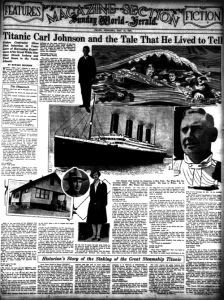
May 15th, 1927 Omaha World-Herald article.
Over a century has sailed by since the horrific night of April, 15th 1912. What was known as the “unsinkable” ship shocked the world when the Titanic submerged after hitting an iceberg. Over half of the passengers did not survive, but Carl Johnson lived to tell his story.
Johnson, at the time of the incident, was a twenty-one-year-old immigrant traveling to the United States. His plan was to escape the draft happening in Sweden by traveling to Wahoo, Nebraska, where his brother lived. He began his adventure by paying a ten dollar premium fee because he believed it was worth being on the “unsinkable ship.” Johnson remembered vivid details about that terrifying night. At around midnight on April 15, the ship hit the iceberg, but no one felt the crash. The passengers were then ordered to go to the deck, but they were not told to bring their lifesavers. The severity of the accident went unnoticed to Johnson until he saw the crew members shooting rockets into the air, followed by ear-piercing screams from the people trapped in the stern where the iceberg had hit. By that time, the ship had started to sink. The last thing Johnson remembers before going into the icy water was watching a giant piano slide off the side of the ship. Then he threw himself into the freezing water. Johnson believed the only reason he survived was because he knew how to swim well.
The next day three people, including Johnson, were pulled to rescue by the Carpathia, another ship. Johnson had been so numb from spending the night in the ice-cold water he could not grasp the rope to pull himself to safety. It had to be tied around him before he could be pulled to the boat. After Johnson’s speedy recovery, he continued on his journey to Nebraska. He settled down in Wahoo, Nebraska until World War I. Carl Johnson and his brother worked at the Havelock shop as carpenters. Carl Johnson’s brother Eric Johnson ended up changing his last name to “Manstedt,” their uncle’s last name, because many people mixed him up with other Eric Johnsons at the shop. Carl on the other hand, was never mixed up with the other Carl Johnson. Carl was known as “Titanic Carl Johnson.”
According to the Omaha World-Herald, when World War I was ongoing, Johnson was one of the first nine men in his town to enter the army under the selective service plan. He was enrolled in September of 1917 and was sent to camp Funston. He stayed until he was dispatched to France that next spring. He then made the Atlantic voyage back to the United States and had better luck on his trip than coming to America in 1912. In 1952, forty years after the Titanic sunk, Johnson told the Lincoln Journal Star he still believed it was inexcusable. Johnson told the paper that the company was too determined to set a new record so they ignored the news about the iceberg they had received the previous day. Also, the ship only carried sixteen lifeboats for over two thousand passengers. “That’s probably all they thought they needed on an unsinkable ship,” Johnson told the Lincoln Journal Star. The legacy of the Titanic disaster still fascinates people today, and it’s interesting to read primary newspaper accounts to see how the disaster and the people involved in it were a cultural obsession even directly after the tragedy. — Brittany Hamor, Editorial Assistant



